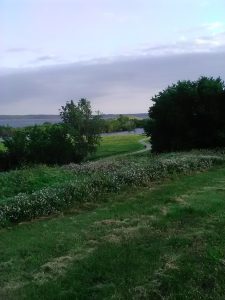One of the most exciting moments of my year, so far, was finding out that Jenny Odell's talk how to do nothing had been transformed into a whole book, and ITS PUBLICATION DATE WAS A WEEK AWAY. (I would make a nerd joke, but this is the library blog. I think everyone will relate.) I love that article, for one, because it taught me some ways to consider time after I graduated from college, when the cycle of study-test-eat-write-read-drink ended and all of a sudden there was TIME, and it was FREE. But I also love that Odell is careful to locate her talk, and by extension her thinking, in a very particular place: the Morcom Amphitheatre of Roses in Oakland, California.
How to Do Nothing has already been featured in a few corners of the library website (see here and here), but I wanted to draw our attention back to one of its main tenets: bioregionalism, and the value of paying attention to the spaces surrounding us, sourcing our ideas and thoughts in our surroundings. Odell writes that “bioregionalism is first and foremost based on observation and recognition of what grows where,” and while I don’t have a good grasp of what grows where in Lawrence, I spend a lot of time doing the observing part.
For Odell, observation of the physical world around us -- including the flowers, land bumps, trees, bees, rain, most of all BIRDS -- has become one of the few remaining ways we can escape from the context-less, streamlined world of social media and 24/7 productivity. “Doing nothing,” Odell would have it, consists of removing our attention from profit-driven black holes and focusing it instead on the sentient and non-sentient beings around us, in the hope that developing a sense of bioregionalism will translate into a sense of community and care. It’s not exactly doing “nothing” -- it’s more like, sitting near some trees and ignoring your phone for a while and watching bugs crawl around. If it sounds boring, I think it’s supposed to. But if we can retrain our attention towards where we are, and when we are, Odell suggests that we can lead more contented lives and strengthen our capacity for collective work, too.
Anyway, in the spirit of Odell, I’m here to share the best spots I’ve found for doing nothing in Lawrence (and suggest some books).
The first spot is not actually in Lawrence (oops) and I hung out there circa 2006, so it doesn't exist anymore except in my memory. It was a tree-cave on the campus of Baker University in Baldwin City. My friends and I snuck around under these trees, which had been planted against a building and so formed a little tunnel between wall and trunk. A great spot for doing nothing, and hiding while at it. I only ever saw bugs and dirt down there, so I think A Field Guide to Insects would have been my best observational tool. That’s what I’d recommend you browse, too, if you find a suitable tree-cave (shrub-cave?).
The second spot is that bench on top of the hill by Clinton Lake. Maybe it’s called Sanders Mound… my searches have been inconclusive. Whatever it’s called, doing nothing after walking up a little hill is probably good praxis. At the very least, there are a lot of butterflies up there to observe (and more bugs).
The third best spot to do nothing, especially if it’s the kind of nothing called waiting, is the set of steps at 7th and Rhode Island, right next to old Borders. They’re pretty shady. Not shady like, “of dubious character,” but shady like, there are bushes around that block the sun for you. You can also sit on the retaining wall and say hi to the occasional person walking by. A good, quiet place to listen for birds.
I recently found a good fourth spot for doing nothing. At the Baker wetlands, there’s an Eagle Scout project that’s about 20 minutes by foot east of the Discovery Center (on the green trail, I think). The project is two benches and a lattice roof. Last time I was there, I saw a muskrat and a heron hanging out together. I never see beavers, but this looks like a fun book anyway.
The last and best spot for doing nothing is, of course, the library. There aren’t any bugs to watch in here, but there are a lot of field guides to aid you in your observations of the world. It can also be difficult to find a public outlet, but if your phone dies, there’s no better place to talk to a stranger.
-Hazlett Henderson is an Info Services Assistant at Lawrence Public Library.






Add a comment to: Where to Do Nothing (in Lawrence)